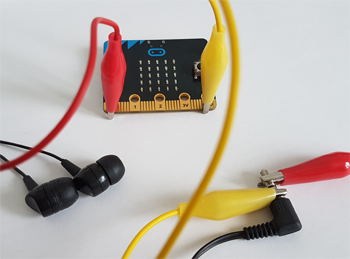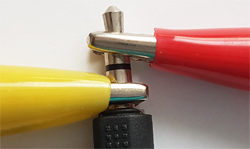| TigerJython4Kids | robotics |
Warning: Undefined array key 0 in /var/www/html/engl/navigation.inc.php on line 32
Warning: Trying to access array offset on value of type null in /var/www/html/engl/navigation.inc.php on line 32
Getting started Python Crash Course LED Display Accelerometer Buttons Sound Compass Sensor Bluetooth Moving Robots Alarm Systems Workheets Worksheet 1 Worksheet 2 Worksheet 3 Worksheet 4 Worksheet 5 Appendix: Digital Display Documentation mbRobot and IoT NEW!
| Deutsch English |
5. SOUND
![]()
YOU LEARN HERE... |
how to connect a headphone or loudspeaker to the micro:bit to play sound sequences and short melodies. |
SOUND OUTPUT |
To hear sounds from the micro:bit, you need a pair of headphones and 2 cables with crocodile clips. Connect the first cable (here with yellow color) to the GND pin and the rear of the headphone plug. The second cable (here with red color) goes from P0 to the front end of the headphone plug. In order to hear the sound in both earpieces, you must try to place the crocodile clip so that it touches the two metallic parts of the plug.
|
EXAMPLES |
|
Play a sequence of tones The command pitch(f, 500) plays a tone with frequency f during 500 milliseconds. To play several notes one after the other, you put the corresponding frequencies in a list and iterate it with a for loop. You can find a table with tones of the musical scale and their corresponding frequencies in the overlay window:Program: from music import * song = [262, 294, 330, 349, 392, 392, 392, 0, 440, 440, 440, 440, 392] for f in song: pitch(f, 500)
Play built-in melodies Program: from microbit import * from music import * while True: if button_a.was_pressed(): play(JUMP_UP) if button_b.was_pressed(): play(JUMP_DOWN) sleep(10)
Play melodies in musical notation The notation uses the following rules:
To compose a melody, you write the notes in a list, for example in the following program for a major and subsequent minor chord. Program: from music import * melody = ['e:4', 'f#', 'g#', 'r:2', 'e', 'f#', 'g:4'] play(melody)
An acoustic position measuring device Measuring devices with acoustic outputs are quite popular. In this application you generate a sound signal whose pitch depends on the lateral inclination of the micro:bit. Starting from an initial frequency f0 = 1000, you compute the rising or falling tone frequencies for semitones of the well-tempered scale and play each tone for 100 milliseconds. With the button B you can turn off the sound. Program: from music import * from microbit import * def beep(n): freq = int(f0 * r**n) pitch(int(r**n * f0), 100) sleep(50) f0 = 1000 r = 2**(1/12) while not button_b.was_pressed(): n = int(accelerometer.get_x() / 100) beep(n) sleep(10) |
MEMO |
| To play a sound you must connect a headphone (or a loudspeaker with a built-in amplifier) to the outputs labeled GND and P0. The command pitch(f, time).emits a tone of frequency f (in Hz) and duration time (in ms). With play(song) you can play whole melodies, either as a sequence of frequencies or in musical notation. |
EXERCISES |
|
Professional hints:
Some sound frequencies:
| Tone | Frequency | Tone | Frequency |
| h' | 494 | h'' | 988 | ||
| a' | 440 | a'' | 880 | ||
| g' | 392 | g'' | 784 | ||
| f' | 349 | f'' | 698 | ||
| e' | 330 | e'' | 660 | ||
| d' | 294 | d'' | 588 | ||
| c' | 262 | c'' | 524 | c''' | 1048 |
Professional hints:
Predifined song lists:
- ADADADUM - the opening to Beethoven’s 5th Symphony in C minor
- ENTERTAINER - the opening fragment of Scott Joplin’s Ragtime classic “The Entertainer”
- PRELUDE - the opening of the first Prelude in C Major of J.S.Bach’s 48 Preludes and Fugues
- ODE - the “Ode to Joy” theme from Beethoven’s 9th Symphony in D minor
- NYAN - the Nyan Cat theme
- RINGTONE - something that sounds like a mobile phone ringtone. To be used to indicate an incoming message
- FUNK - a funky bass line for secret agents and criminal masterminds
- BLUES - a boogie-woogie 12-bar blues walking bass
- BIRTHDAY - “Happy Birthday to You...”
- WEDDING - the bridal chorus from Wagner’s opera “Lohengrin”
- FUNERAL - the “funeral march” otherwise known as Frédéric Chopin’s Piano Sonata No. 2 in B♭ minor.
- PUNCHLINE - a fun fragment that signifies a joke has been made
- PYTHON - John Philip Sousa’s march “Liberty Bell” aka, the theme for “Monty Python’s Flying Circus”
- BADDY - silent movie era entrance of a baddy
- CHASE - silent movie era chase scene
- BA_DING - a short signal to indicate something has happened
- WAWAWAWAA - a very sad trombone
- JUMP_UP - for use in a game, indicating upward movement
- JUMP_DOWN - for use in a game, indicating downward movement
- POWER_UP - a fanfare to indicate an achievement unlocked
- POWER_DOWN - a sad fanfare to indicate an achievement lost
Professional hints:
In the well-tempered tuning the octave (doubling of the frequency) is divided into 12 semitones with the same frequency ratio r. So the following applies: r12 = 2 or
| r = |
Professional hints:
Instead of headphones, you can also use a cheap, amplifier-powered speaker (such as a "hamburger box") (but not a simle loud speaker without an amplifier).




